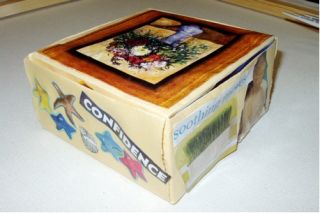
Depression
The Distinctions Between ♂ and ♀ Inmates in Art Therapy
Comparison between male and female inmates as emerged thru art therapy research
Posted January 21, 2014

The research agenda that the previous three posts have presented culminated in a reexamination of the differences between male and female inmates (those posts can be found here, here and here).
What emerged was exciting. The stats revealed that female inmates seemed to demonstrate greater improvement than the men in mood and internal Locus of Control (LOC) through art therapy. Upon closer examination, although the women's symptoms were measurably more improved, the women started with worse scores on the assessments—that is, they exhibited greater depression and their LOC was more external than the male inmates to begin with. This bore further examination:
1) Female inmates exhibited higher levels of depression than their male counterparts at the start of the study
The literature supports that although both genders experience depression, women report more severe symptoms (Butterfield, 2003). Because of the social and maternal hardships prison places on female inmates—more so than is placed on the men—women may develop higher levels of depression, anxiety and somatic complaints than the men, who may display more anti-social tendencies. While men and women are in an environment where admission of weakness are taken advantage of women seem less reluctant to admit to problems; in fact, they often work with one another through empathy and family-like support.
2) Female inmates exhibited a more external locus of control than their male counterparts at the start of the study
The literature indicated that female inmates may be more reactive towards interactions with others—they may be more influenced by external factors (Zingraf, 1980) and that male inmates are deemed to have more of an internal LOC than female inmates (DeWolfe, Jackson & Winterberger, 1988). This may be reflected in their crimes. Women are likely to be provoked through domestic and sexual abuse which may result in crimes against their partners or their abusers. They may have also been pushed into committing a crime by a “loved” one, or feel they must do so to protect their family.
Men’s crimes, though reflecting poor decisions, may be more ‘self-motivated’. That is not to say that men’s crimes are not a result of social interaction, but perhaps less so than women. Literature also stresses female inmates seem more dependent by the prison staff, emerging as an external LOC.
3) The men and women ended with similar scores in depression and locus of control. Were female inmates more susceptible to art therapy interventions?
It was unclear if the women showed greater change because their scores started lower, needing greater improvement to rise to the same level. It may be female inmates responded better to art therapy, as some suggest women prefer alternative therapies (Risberg, et al, 2004). They may also respond better to group support as Day & Onorato (1997) and Zingraff (1980) indicated.

men's group sculpture
Although men responded well to art therapy groups, they focused on final products; their natural competitiveness “obligated” them to “do good art.” The women seemed content with creating an art piece, but did not concentrate on a final result. While the women complimented each other’s work, they didn’t focus on how their art compared to someone else’s. The women used the art process to discuss and empathize.
While the men realized that they needed to interact with one another in order to create a group product, the women seemed content with simply interacting; the final piece was of secondary importance.
Regardless that the men and women may have raised their scores close to one another, how they responded to the art therapy seemed to differ. Although the men may have indicated how thankful they were that they were supported individually in the art sessions, the women exhibited more empathy.
Differences personified
Early in one women’s group, several participants made self-deprecating comments. One woman indicated:
“I am sick and tired of everyone’s shifting mood from hate to pity. There is no consistency. I colored in my whole picture because I feel boxed in, suffocated by anxiety.”
As the group progressed, she began to understand her relationship within the group. She helped others; she reflected on how important it was for her to develop her own identity while still able to work with the others. As an art therapy intern indicated:
“The group has matured; they were able to empathize with each other.”
The art therapy provided them a common ground of expression to recognize their individual contribution to a group process, reinforcing their own sense of identity. This in turn may have improved their mood and strengthened internal control; they witnessed their own valuable contributions and thus trusted their own judgment.
These reactions seemed different from the men’s.
When the men became angry or disgusted in the group, they would encourage calm, egg each other on, or ignore and silently watch the reactions. Sometimes, the men talked at each other, rather than with each other. Even when the men voiced empathy, it seemed superficial, reflecting more on how other’s concerns related to their own personal difficulties and issues.
Yet the men knew that to complete a group product they needed to work together, to cooperate. They curbed frustrations in order to communicate; eventually others within the group—and outsiders who saw what they did—complimented their final products. Their mood improved as they could express themselves in a way that was not condemned, and they developed greater internal LOC through their ability to understand how valuable their own decision-making was in the success of the product.
These differences on how the male and female inmates responded to the art therapy interventions forced a reevaluation of some of the theoretical constructs of how art therapy benefits prisons.
[As in the previous posts, the article that documented these results are available for immediate download. To review this article, you may find this article in The Arts in Psychotherapy here. It is also available on the website www.arttherapyinprison.com.]
woman's self-box References

woman's self-box
References
Blitz, C.L., Wolff, N., Pan, K. & Pogorzelski, W. (2005). Gender-specific behavioral health and community release patterns among New Jersey prison inmates: Implications for treatment and community Reentry. American Journal of Public Health, 95(10), 1741-1746.
Butterfield, F. (2003, October 22). Study finds hundreds of thousands of inmates mentally ill. New York Times. Retrieved April 21, 2008, from http://query.nytimes.com.
Day, E.S. & Onorato, G. T. (1997). Surviving one’s sentence: Art therapy with incarcerated trauma survivors. In D. Author and E. Virshup (Eds.), Drawing Time: Art Therapy In Prisons and Other Correctional Settings. (pp.127-152). Chicago, IL: Magnolia Street Publishers.
DeWolfe, T.E., Jackson, L. E. & Winterberger, P. (1988). A comparison of moral reasoning and moral character in male and female incarcerated felons. Sex Roles, 18, ( 9/10) 583-593.
Gussak, D. (2009). Comparing the effectiveness of art therapy on Depression and Locus of Control of male and female inmates, The Arts in Psychotherapy, 36 (4), 202-207
Love, G.D. (1991).Consideration of the inmate student's locus of control for effective instructional leadership. Journal of Correctional Education, 42 (1), 36-41.
Risberg, T., Kolstad, A., Bremnes, Y., Holte, H., Wist, E.A., Mella, O., Klepp, O, Wilsgaard, T., & Cassileth, B.R. (2004). Knowledge of and attitudes toward complementary and alternative therapies: a national multicentre study of oncology professionals in Norway. European Journal of Cancer, 40, 529–535
Zingraff, M. T. (1980). Inmate assimilation: A comparison of male and female delinquents. Criminal Justice and Behavior, 7, 275-292.



